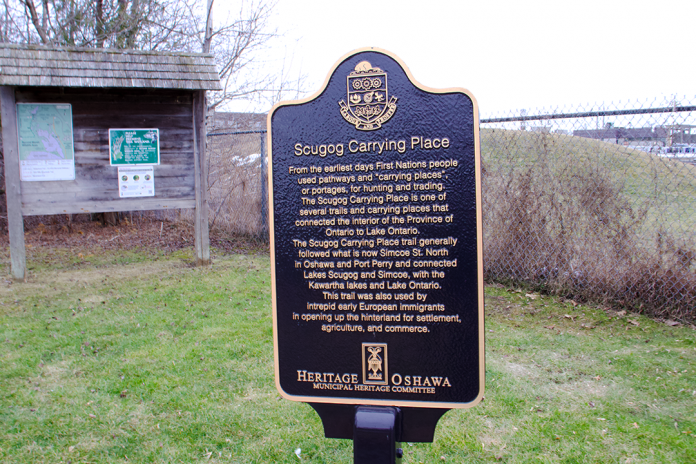While sitting in class at Durham College, the ground beneath the campus is rarely given much thought. It seems as if it has always been the same or as if nothing existed here before. However, beneath the daily foot traffic of students lie the remnants of thousands of years of First Nations migration and trade.
Located in Oshawa off Colonel Sam Drive, Heritage Oshawa has marked the location of where the paths may have begun.
Taynar Simpson, chief of Alderville First Nation, said archaeological findings have often led to misconceptions about the trail’s origins.
“The Wendat are often erroneously attributed to a lot of things in southern Ontario,” he said. “For the last 100 years, the archaeologist’s narrative has always been to attribute things to the Huron-Wendat.” Once the archaeologists actually concluded their research, Simpson said they found that these trails were Anishinaabe Mississauga all along.
The trail was used as a tool for migration and trade for centuries, according to Simpson.
“A trail system like this, used over and over again, was like our highway,” he said.
He explained that the trails followed seasonal migration patterns. In winter, larger groups would disperse using the paths to reach family hunting grounds and camps.
“We would break up (in the winter) and then come back together in the spring and summer,” he said. “These trails were used to disperse to our seasonal hunting grounds and to return to our summer grounds.”
For many Oshawa residents, exploring the history and significance of these paths and documenting their locations is a passion.
The Oshawa Museum has been showcasing an exhibit featuring artifacts and Information about the Carrying Place since 2017 in an ongoing project to share the history of the trails.
Melissa Cole, the museum’s curator, shared a historical map showing where the trail may have been located based on the first map of Whitby Township in 1794.
The map highlights modern locations as well as archaeological sites, such as the Grandview and Macleod sites, where artifacts have been discovered. Some of these artifacts are now part of the museum’s collection.
The exhibition aims to highlight the historical importance of the Scugog Carrying Place and its ties to Indigenous communities in the area.
“Today we now tell a fuller story and complete story that includes showcasing the Mississauga and Haudenosaunee as well,” said Cole, who collaborated with author Grant Karcich, who has written three books on historical pathways in southern Ontario, focusing on preserving local history and mapping ancient trails.
“The main document that identified the trail is the survey map of Whitby Township in 1794,” Karcich said. “It clearly lays out a trail, so we know it was in use at that time and can see exactly where it was.”
When describing seasonal migration patterns, he said, “The Mississauga would use it to come down from Lake Scugog.”
This specific trail stretched far from the port of Oshawa all the way up to Port Perry with migration occurring in the summer and winter months, coinciding with fishing and harvesting.
Oshawa resident Keith Jones has also worked to document the path’s legacy. In 2020, he began plotting where the trail would have been and created the Scugog Carrying Place website, sharing how the trail looks overlayed on a modern day map.
“I plotted that trail as best I could so people could see that trail and go stand on that place,” said Jones. “And here’s the hook it goes right through the campus.”
As more people discover the significance of the Scugog Carrying Place, its legacy continues to inspire a deeper connection to the land and its history. Ongoing research and community involvement help ensure the story of these paths remains alive in Oshawa today.
The efforts to preserve and understand the trail serve as a reminder of the enduring relationship between Indigenous peoples and the land they have walked for millennia.
“This area is attributed to the Mississauga,” Simpson said. “We had networks and travel routes established for thousands of years through this area.”




